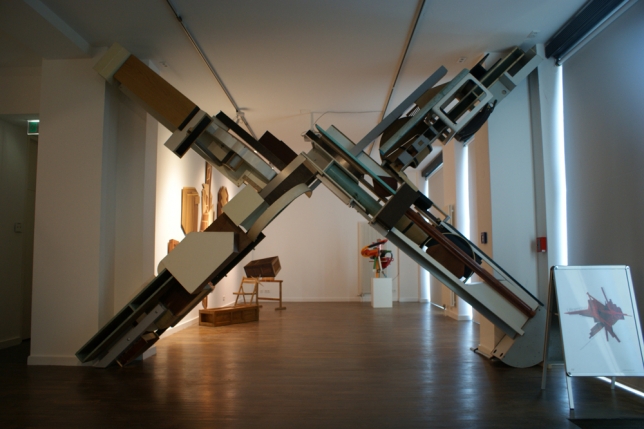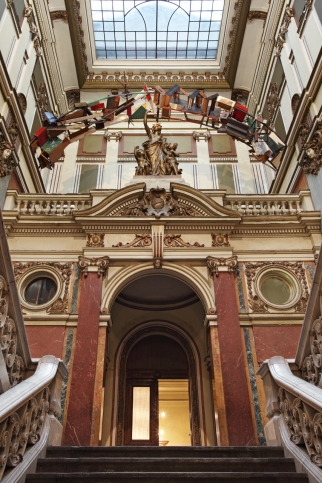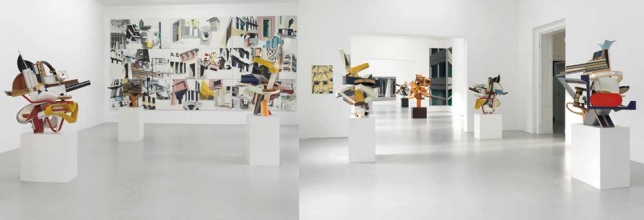19.01. – 14.02.08
Karsten Konrad / Tim Trantenroth
Two person exhibition at Arndt & Partner, Berlin
Karsten Konrad
Born 1962 in Würzburg, Germany
Lives and works in Berlin, Germany
Karsten Konrad started in the 1990s to create installations and objects out of materials found in the trash and subsequently modified into modules. With these, he took up thematically outstanding urban structures in Berlin, transforming them into idiosyncratic architectural models. In recent years, however, these model-like works have made way for increasingly abstract sculptures and relief works. Since the original point of departure for Konrad’s work as an artist was the autonomous abstract sculpture, this may seem like a return to his beginnings. However, it should rather be understood as the consistent continuation and expansion of his sculptural transformations of architecture, which in terms of form he liberated from their strict character as models, calling them “explosions of architecture.”
International group exhibitions include: "Gebaute Welten" at vitrine-fn, Friedrichshafen, Germany (2013), "Abstract Confusion - Malerei, Skulptur, Video" at the Kunsthalle Erfurt, Erfurt, Germany (2012), "What Happened to the Museum of Contemporary Art?" at the Muzej savremene umetnosti Beograd, Belgrad, Serbia (2012), "Berlin 89/09: Kunst zwischen Spurensuche und Utopie" at the Berlinische Galerie, Berlin, Germany (2009/2010), "Night on Earth. Connecting Urban Art Scenes in Berlin, Shanghai and Helsinki" at the MOCA Museum of Contemporary Art Shanghai, China (2008), "Neuer Konstruktivismus" at the Bielefelder Kunstverein, Bielefeld, Germany (2007), "Shift/Scale" at the Kumu Art Museum, Tallinn, Estonia (2006), "SIART Biennial", La Paz, Bolivia (2005), "Quobo" at the Hamburger Bahnhof, Museum für Gegenwart, Berlin, Germany (2001) and "berlin_london_2001" at the ICA, London, UK (2001).
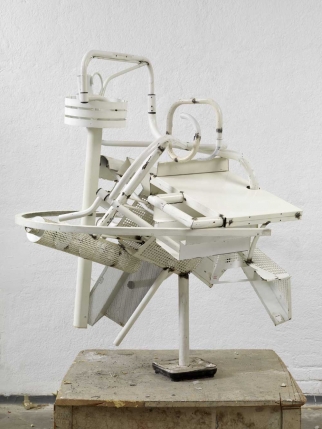 Karsten Konrad, White Ninja, 2011, Metal, Aluminium, 130 x 160 cm | 51.18 x 62.99 in, Photo: Bernd Borchardt
Karsten Konrad, White Ninja, 2011, Metal, Aluminium, 130 x 160 cm | 51.18 x 62.99 in, Photo: Bernd Borchardt Karsten Konrad at Künstlerhaus Bethanien, Berlin from 24 September to 10 October 2010
Karsten Konrad at the Polish Institute of Berlin "Ultramoebel"
Karsten Konrad is part of the group exhibition "abstract confusion" at b-05 art- and culture center in Montabaur, Germany, from 15 May to 14 August 2011
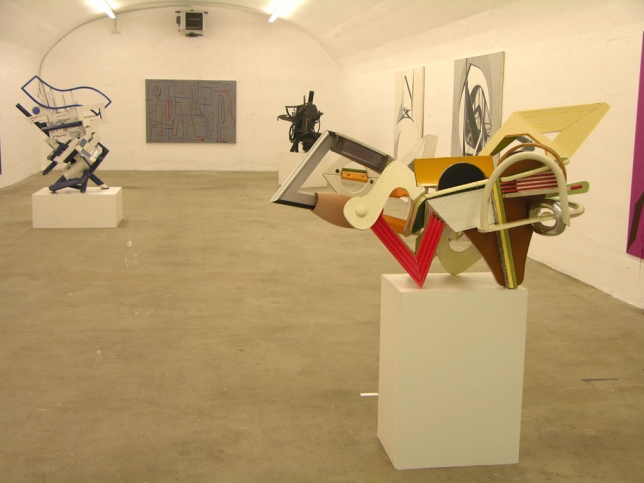 Karsten Konrad, Exhibition view of "abstract confusion" at b-05, Montabaur, May - August 2011
Karsten Konrad, Exhibition view of "abstract confusion" at b-05, Montabaur, May - August 2011
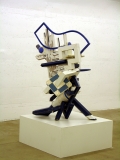 Karsten Konrad, Blue Bajou, exhibtion view "abstract confusion" at b-05, Montabaur, May - August 2011 , 2010, wood, coated chipboard, metal, plastic, ceramic, 170 x 123 x 110 cm | 66.93 x 48.43 x 43.31 in
Karsten Konrad, Blue Bajou, exhibtion view "abstract confusion" at b-05, Montabaur, May - August 2011 , 2010, wood, coated chipboard, metal, plastic, ceramic, 170 x 123 x 110 cm | 66.93 x 48.43 x 43.31 in
The exhibition "abstract confusion" gathers 22 current outstanding artistic positions from the last ten years where one can see a clear development of new abstraction. This exhibition will present stars from the scene for example, Frank Nitsche and Thomas Scheibitz and newcomers such as, Wolfgang Flad and Shannon Finnley.
The current theme "abstraction" is elevated and the exhibition will provide one an overview of our contemporary abstract tendencies throughout all media. The theme will unfold itself through painting, photography, sculpture, installations and videos out of the abstract context. What is the specific "new" in new abstraction? What does it mean when artists turn to abstraction? Is it turning away from reality or is there an underlying aesthetic utopian counter development?
Karsten Konrad participates the group exhibition ABSTRAKT //// SKULPTUR at the Georg-Kolbe-Museum, Berlin from 26 June to 4 September 2011
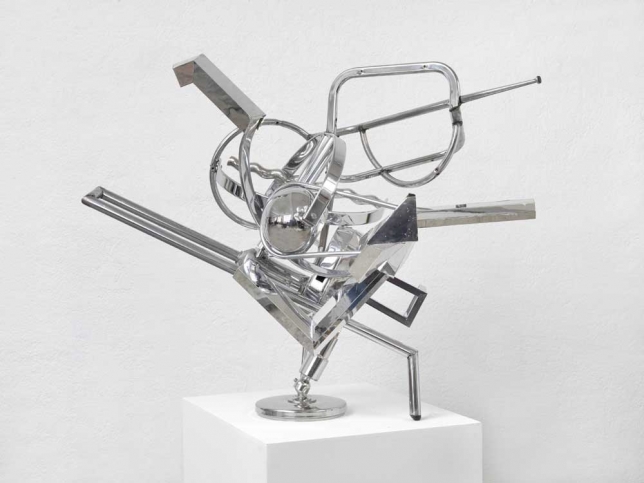 Karsten Konrad, Bella Macchina, 2011, chrome steel, mdf with mirror pvc, 98 x 120 x 110 cm | 38.58 x 47.24 x 43.31 in
Karsten Konrad, Bella Macchina, 2011, chrome steel, mdf with mirror pvc, 98 x 120 x 110 cm | 38.58 x 47.24 x 43.31 in
ABSTRAKT //// SKULPTUR
Gruppenausstellung zur neuen Abstraktion in der zeitgenössischen Skulptur.
Mit Werken von:
Cristian Andersen
Florian Baudrexel
Wolfgang Flad
Martin Flemming
Nadja Frank
Amélie Grözinger
Knut Henrik Henriksen
Gregor Hildebrandt
Olaf Holzapfel
Jeroen Jacobs
Isabel Kerkermeier
Thomas Kiesewetter
Karsten Konrad
Gereon Krebber
Alicja Kwade
Wilhelm Mundt
Manfred Pernice
Bettina Pousttchi
Thomas Scheibitz
Felix Schramm
Katja Strunz
Johannes Weiß
Etwa hundert Jahre ist es her, dass die Kunst – zumindest in Teilen – ungegenständlich geworden ist. Ein Monopol hatte die Abstraktion seitdem nie, aber es gab Zeiten wesentlicher Marktbeherrschung, auf die dann wieder figürliche Gegenbewegungen folgten. Die Oppositionen abstrakt / figurativ und Formalismus / Realismus waren vor allem in der Nachkriegszeit nicht nur künstlerisch sondern auch gesellschaftlich ideologisch besetzt. Eine Generation, die nach 1990 ihre prägende künstlerische Sozialisation erfuhr, fand jedoch die Abstraktion als weitgehend entideologisiertes Konzept vor, das weder politischen noch ästhetischen Reinheitsgeboten mehr unterlag. Die Vor- und Nachkriegsmoderne ist für die hier behandelte Generation von Künstlerinnen und Künstlern ein Steinbruch mit unterschiedlichen Lagerstätten, die im Sinne des musikalischen Samplings neu miteinander kombiniert werden können, um sie einer aktuellen Lesart zu unterziehen. Werke aus den letzten zehn Jahren dokumentieren die Aktualität einer Neuen Abstraktion im Spektrum der Gegenwartskunst.
ABSTRAKT //// SKULPTUR wurde kuratiert von Marc Wellmann und ist die erste Überblicksausstellung aktueller ungegenständlicher Bildhauerei in einer deutschen Institution. Die Werke treten dabei in Dialog mit den Plastiken Georg Kolbes, einem der bedeutendsten figürlichen Bildhauer der Moderne.
Wir bedanken uns bei der freundlichen Unterstützung durch folgende Galerien:?401contemporary, Arndt, Lena Brüning, Buchmann, Contemporary Fine Arts, Hammelehle und Ahrens, Koal, Johann König, Gebr. Lehmann, Sommer & Kohl, Wendt & Friedmann und Wentrup.
KATALOG: Zur Ausstellung erscheint ein Katalogbuch mit Texten von Marc Wellmann und Juliane Kobelius. 64 Seiten, Format: 24 x 16,5 cm, Hardcover.
Verkaufspreis in der Ausstellung: 12 Euro
Die Publikation wurde ermöglicht mit freundlicher Unterstützung der Sammlung Peters-Messer, Viersen.
Karsten Konrad is part of the 53rd October Salon in Belgrade, 22 September to 4 November 2012
Exhibitions
PRESS RELEASE
Arndt & Partner Berlin is pleased to announce a joint exhibition by Karsten Konrad and Tim Trantenroth in the Gallery 2nd Floor. The two Berlin artists collaborated for the first time for this show. The point of departure for this cooperation was the fact that both in Karsten Konrad's sculptural works and Tim Trantenroth's paintings, we can observe an intense engagement with the urban architectural structures of the city where they live and work.
Thus, Karsten Konrad started in the 1990s to create installations and objects out of materials found in the trash and subsequently modified into modules. With these, he took up thematically outstanding urban structures in Berlin, transforming them into idiosyncratic architectural models. In recent years, however, these model-like works have made way for increasingly abstract sculptures and relief works. Since the original point of departure for Konrad's work as an artist was the autonomous abstract sculpture, this may seem like a return to his beginnings. However, it should rather be understood as the consistent continuation and expansion of his sculptural transformations of architecture, which in terms of form he liberated from their strict character as models, calling them "explosions of architecture."
In contrast to Karsten Konrad, Tim Trantenroth uses paintings to develop his themes. In his works, we find an emphatic engagement with the construction principles of modern functional buildings. Thus in his paintings we often encounter adaptations of typified but versatile facade designs, as well as the side effects of this architecture like, for example, surveillance cameras or uncounted variations of concrete barriers. His paintings are very reduced and simplified both in their formal language and their colours, corresponding to the dull grey of contemporary architecture. Individual features of the painted buildings become only visible on close examination; sometimes Trantenroth makes reference to a certain building in his titles: Chancellery, Finance Ministry, or Danish Embassy in Berlin. But the titles do not just refer to the respective sites, but also to the specific meaning of architecture in its symbolic dimension.
Karsten Konrad, born in Würzburg in 1962, studied at the Berlin University of the Arts and the Royal College of Art, London. He lives and works in Berlin. International group exhibitions include "berlin_london_2001", ICA, London (2001), "Quobo", Hamburger Bahnhof - Museum für Gegenwart, Berlin (2001), the SIART Biennial, La Paz, Bolivia (2005), "Shift/Scale", Kumu Art Museum, Tallinn (2006), "Neuer Konstruktivismus", Bielefelder Kunstverein, and Changing Spaces, Städtische Galerie Waldkraiburg (both 2007). He recently presented solo exhibitions at loop - raum für aktuelle kunst, Berlin (2006), and Arndt & Partner, Zurich (2007). Currently he is participating in the exhibitions Minsk, urban diary, Centre for Contemporary Art, Gdansk (until 13.1.2008), and "Quobo - Kunst in Berlin 1989-1999", Eesti Kunstimuuseum, Tallinn (until 17.2.2008).
Tim Trantenroth, born 1969 in the Fichtelgebirge, Germany, studied at the Academy of Fine Arts Münster and the Art Academy Düsseldorf. He lives and works in Berlin. He presented solo exhibitions at the Kunstruimte Villa de Bank, Enschede (2005), and Förderverein Aktuelle Kunst, Münster (2002), among others. Group exhibitions he participated in include "Cada uno para sí y Dios contra todos", OMR Gallery, Mexico City (2007), "Classified", The Cartin Collection, Hartford, Connecticut (2006), Uwaga Berlin, Baltic Gallery of Contemporary Art, Slupsk, Poland (2005) and open minded, dollhouse Orchard Street, New York (2004), which he co-curated. This is his first exhibition at Arndt & Partner Berlin, after we had introduced him to the Swiss public with his solo show in Zurich in 2006.
15.03. – 21.04.07
Karsten Konrad
“Zig Zag Zurich”
Solo exhibition at Arndt & Partner, Zurich
PRESS RELEASE
In his first solo show with Arndt & Partner in Zurich, the Berlin based artist Karsten Konrad performs a kind of tour de force through the history of art of the 20th century by embracing elements of Cubism, Constructivism, Surrealism, Ready-made, Abstract Expressionism, Pop Art and Minimal.
Bulky waste items and furniture parts are used in the creation of his sculptures, which can be divided into three groups: wall pieces in relief, which resemble Abstracts on wood; wall sculptures, which disregard static geometries and interplay with the wall itself; and, finally, flowing, playful, dance-like forms and statically constructed architecture. Here, the viewer is exposed to three-dimensional logos, graffiti tags or exploding architectural situations.

